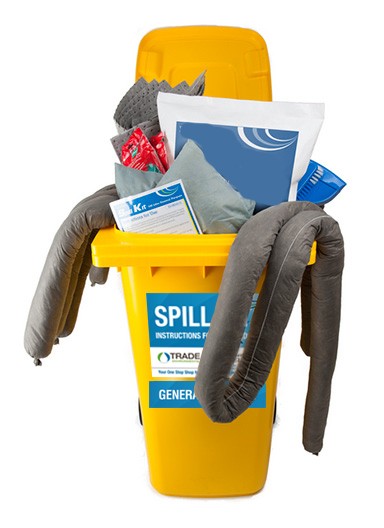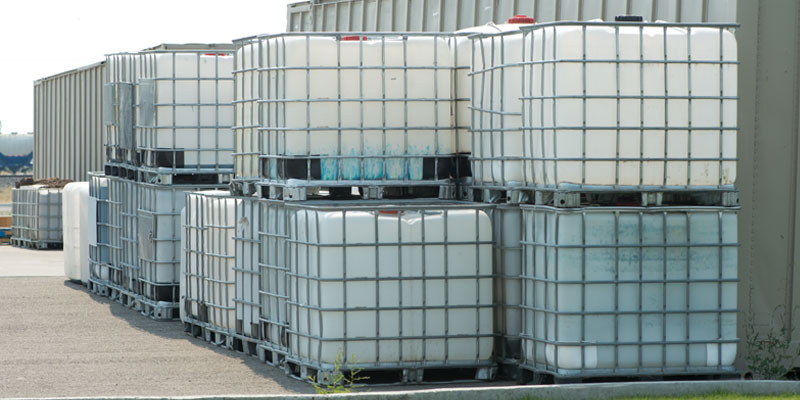🔑 Key takeaways:
Most of today’s businesses have to use and deal with various liquids, oils and chemicals. Many commonly used liquids – especially when stored in abundance – can present a spill hazard. Spills of dangerous or voluminous liquids need to be included in management plans to avoid risks of injury, damage and environmental pollution. In this article, we are going to learn about the first line of hazardous spill management – the use of spill kits. The materials in a proper spill kit will help you clean up the spill while preventing worker injury and leaching chemicals into the environment.
Is your workplace at risk of a hazardous spill?
When we talk about spill risks, big industrial complexes and oil infrastructure usually first come to mind.
However, we must not forget that many other facilities, from medical institutions to small workshops, work with potentially hazardous liquids on a day-to-day basis.
Spills are best prevented. Good management and diligent application of safety procedures in accordance with local and international standards will minimize the risk of a dangerous spill. Unfortunately, even the most organized systems can and will face unpredictable and uncontrollable circumstances – think human errors, or unpredictable weather and natural events.
When working with any type of liquids – spills are not a matter of “If”, but a matter of “When.”
No matter what the quantity of liquids your company is working with, to be responsible toward human and environmental health, and compliant with the local safety regulations, you need to equip the workplace with tools for spill mitigation.
The fundamental tools and materials are contained within spill kits, and fortunately, they are easily obtainable.

What Are Spill Kits?
Spill kits are an essential part of a functional workplace that has chemicals, fuels, oils, or other aggressive and non-aggressive liquids stored within its facilities.
The right spill kit will help to deal with an accidental spill in the safest possible manner.
By using the proper clean-up equipment, you are avoiding damage for your employees, your property, the environment, and your business productivity since less time is wasted on inefficient, improvised spill cleanups.
Besides, direct safety, possession of spill kits will help you comply with the legal aspects of running a business. If you are operating in Australia, know that the EPA will fine all breaches of safety legislation, as well as charge additionally for the required cleanup.
Safety regulations are an integral part of any healthy society’s care about the safety of its members and stakeholders. All economic subjects have a shared responsibility for our common environment.
While securing proper spill kits may seem burdensome, it pays off both financially and morally to have them always at hand and ready for a potential accident.
How to Deal With An Average Spill
There are a few fundamental points of great importance for an efficient and safe spill response:
- Choosing the right type(s) of spill kit(s) for your activities.
- Ensuring your staff is trained to use spill kits properly, and is always up-to-date on spill kit training.
- Knowing the right institutions, departments, and service providers to call in the case a spill gets out of hand, or is extremely dangerous by its very nature.
- Preparing an easily accessible Safety Data Sheet, in accordance with your local OSHA recommendations, for each liquid on the site.
No matter what is the type of spill kit you are using, here are basic steps for handling an average spill with the help of a universal spill kit.
Choose the right spill kit
The type of spill kit you will use depends on the properties and the quantities of the liquids you are using – that is, the size and the type of the potential spill.
The three main types of spill kits are:
Put on protective equipment before handling anything related to the spill
It is critical to put on protective gear before any handling of the spill takes place. Even seemingly benign chemicals like detergents can cause serious harm if they end up e.g., in your employee’s eye.
Stop the discharge
To avoid increasing the risk and the workload, stopping any discharge from a leaking barrel prior to tending to the spill is a commonsense step. You can use a wooden wedge or a nail to plug any holes, or use resins and other substances specialised for the purpose that often come included in the spill kits.
Prevent the liquid from escaping the site
Most sites have terrain configuration that is designed to direct any pooling liquid towards a storm drain. However, in the case of a chemical or oil spill, this is highly undesirable as it will lead to chemicals leaching into and potentially harming the natural environment. That is why all spill kits contain special pads or sheets that prevent the liquid from escaping into the drain.
Stop the spread of the liquid
As the liquid will continue to spread, one thing you would like to do before doing the actual cleanup is to limit the spread. Spill kits contain absorbent socks that are used at the borders of the spill to circle it.
Use spill kit absorbents to absorb the pooled liquid
After all the preventive measures have been taken, it is time to do the actual cleanup. Spill kit absorbent pads or pillows will remove the liquid while minimizing the worker’s contact with the substance. Absorbents are usually simply laid over the spill and then disposed of – no messy smudging or scrubbing required.
Dispose of the soaked absorbent properly
After absorbent pads have been maximally saturated, the worker will use them to gently scoop up any remaining liquid and then dispose of them. It is highly important to dispose of the pads properly – meaning to put them in the right waste bins. The disposal will depend both on the properties of the liquid, and the properties of the pads. If you are unsure, there are local waste departments you can call and make an inquiry.
Restock the spill kits
Because spills are unpredictable events, it is important to be ready at any given moment. Restocking the spill kit materials promptly to have them ready for the next accident.
Spills beyond basic spill kit response
There are spills that are beyond the capabilities of non-OSHA employees, typical spill response training and regular spill kits. These include
- Spills that represent an exceptional or immediate hazard
- Highly dangerous and/or toxic chemicals,
- Radioactive spills,
- Spills with fire and explosion potential.
- Large-scale or overwhelming moderate spills beyond basic spill response capabilities.
The contact numbers of your local responders (e.g., local chemical safety department), whose duty is to help in a highly hazardous situation, should be easily visible and accessible to all your staff at all times.
Inspecting the spill kits
How often should spill kits be inspected? It depends on whether they are unused – sealed, or used – unsealed.
There is no need to check sealed pill kits on a weekly or monthly basis. Just occasionally make sure there are enough spill kits and that they remain in their designated area. However, once or twice a year, break the seal and check if anything has degraded by itself and are there any replacements needed.
For unsealed spill kits, it is recommended to monthly check if all the elements are present and functional. Using checkup lists which contain info on the content of the spill kit drums and the key questions regarding their functionality, is very practical and highly recommended.
Summary
Spill kits are an essential part of any productive and responsible working environment with even the slightest risk of chemical, oil, or other liquid spills. By stocking the right spill kits and training your staff to properly use them, you reduce the risk of harm for the people, the environment, and your business. There are basic steps for handling a spill with the help of a spill kit, however, the exact strategy will depend on the spill type and the available kits.


